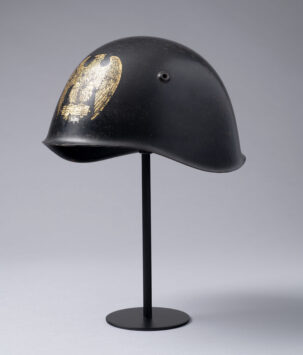-
Principal part of a larger sculpture known as ‘Empire Springs from the Mind of Il Duce‘ or ‘L’Impero balza dalla mente del Duce‘ in Italian, Ferruccio Vecchi masterfully portrays Mussolini as the Fascist superman destined to lead Italy to glory. A strong cult of personality was constructed around Mussolini, not only to inspire loyalty but for him to serve as a role model for the citizenry as an idealized vision for Italy’s ‘New Man’.
-
A monumental Italian bronze eagle with outstretched wings, perched atop an obelisk forming the letters “EIA” and along the pedestal base the Latin motto “MAGIS MAGIS QUE”.
-
Irredentist lithograph by Alberto Martini depicting an ethereal personification of Italy as she stands triumphantly over the Austro-Hungarian Empire. Austria-Hungary is represented by a beastly reptilian interpretation of Emperor Franz-Joseph,, seen claiming rightfully Italian lands for himself.
-
Profilo continuo del Duce (Continuous profile of the Duce) from 1933 is a Futurist rendition of Mussolini’s distinctive side profile continuing a full 360 degrees. Futurism has been long associated with Fascism, with this sculpture, in its dynamism and movement, typifying Futurist works of art. It was approved as an official portrait by the Duce himself as one of many Futurist political artworks surrounding his cult of personality,
-
Poster promoting the Mostra della Rivoluzione Fascista (Exhibition of the Fascist Revolution), which was an art exhibition intended to commemorate the revolutionaries who had taken part in the rise to power of Fascism. Fascism has been closely linked to avant-garde artistic movements such as Futurism. As reflected in its ideological doctrine, Italian Fascism was much more open towards new ideas and lacked the counterproductive fixation on stylistic purity and traditionalist realism that defined the Nazi aesthetic.
-
Poster promoting the Mostra della Rivoluzione Fascista (Exhibition of the Fascist Revolution), an art exhibition intended to commemorate the fascist revolutionaries who partook in the rise of Fascism in Italy. This example highlights the exhibition’s opening on the 10th anniversary of the March on Rome. Italian Fascism was closely linked to avant-garde artistic movements such as Futurism, and as reflected in its ideological doctrine, its art embraced modern ideas and lacked the counterproductive fixation on stylistic purity and traditionalist realism that defined Nazi art.
-
The Milizia Volontaria per la Sicurezza Nazionale (MVSN), commonly referred to as the Blackshirts, was the main paramilitary wing of the National Fascist Party. They were the Italian equivalent of the German Schutzstaffel (SS) after which the latter was based upon. Surmounted on the chain is an “M” standing for Mussolini and an eagle clutching the letters “SPQR”, an abbreviation for the Roman Empire which the Italian fascists sought to emulate. The centrality of ancient Rome’s role within the palingenetic mythos of Italian Fascism cannot be understated.
-
An Italian M33 helmet for a general of the Milizia Volontaria per la Sicurezza Nazionale (MVSN), commonly referred to as the Blackshirts. The MVSN was the main paramilitary wing of the National Fascist Party, and the Italian equivalent of the German Schutzstaffel (SS) after which the latter was modeled upon.
-
Postcard commemorating successive Japanese victories in the Pacific. The Imperial Japanese Navy is personified here as a mighty samurai. The subsequent fall of British Malaya and Singapore to the Japanese was described as “the worst disaster and largest capitulation in British history” by Prime Minister Winston Churchill. Backed by the three flags of the main Axis powers, it highlights the supremacy and solidarity of the fascist triumvirate as they continued to enjoy victory on all fronts.
-
Sleek silver plated dagger with its crossguard and blade forming a fasces, a widely used symbol in Fascism from which the ideology derives its name. Gifted to Alessandro Pavolini, secretary of the Republican Fascist Party who was noted for his uncompromising fanaticism that exceeded Mussolini’s. He is seen by historians as being one of the primary instigators of the Italian Civil War and one of the founders of the hardline Italian Social Republic.









